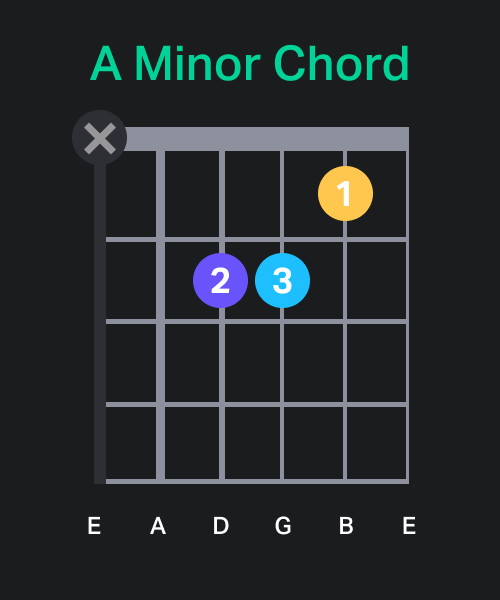News
Are you new to playing the guitar and eager to learn more chords? In this article, we’ll guide you through playing the A minor chord on the guitar. Whether you’re a beginner or looking to refresh your knowledge, we’ll teach you correct finger placement, the best technique to master this essential chord, and some great alternatives to enrich your playing. Let’s get started!
Table of contents
Learn the Am guitar chord
The A minor chord is great for beginners, which is why it’s one of the first guitar chords many learn. A minor chord is often indicated with a lowercase “m.” Therefore, the A minor chord can simply be called the Am chord.
Here’s a step-by-step guide to playing A minor:
- Position your index finger: Place your index finger on the first fret of the B string (2nd string).
- Add your middle finger: Place your middle finger on the second fret of the G string (3rd string).
- Position your ring finger: Place your ring finger on the second fret of the D string (4th string).
- Strum down from the A string: Start strumming down from the A string (5th string) to the high E string. Don’t strum the low E string (1st string) to avoid adding unwanted notes to the chord.
Tip: Position your fingers close to the frets without pressing them directly. Putting your finger on the fret will cause the strings to buzz. Also, make sure you curve your fingers so they don’t touch adjacent strings. It’s easy to mute the high E string with your fingers accidentally.
Below is a guitar chord chart for A minor (or Am):

What’s the difference between minor and major chords?
The difference between a major and minor chord lies in the arrangement of their notes, specifically in the interval between the root note and the third note in the chord. The root note (in this case, A) gives the chord its name.
In a major chord, the interval between the root and the third is a major third, creating a bright and uplifting sound. In a minor chord, however, the interval is a minor third, which produces a darker, more melancholic tone. This slight change in pitch gives minor chords their characteristic sound.
Let’s look at the Am and A chords.
- The A minor chord consists of A, C, and E. In the A minor chord, the third note is a minor third interval from the root note, resulting in a melancholic and somber sound.
- The A major chord consists of A, C#, and E. The variation in the third note is what distinguishes A major from A minor. The A major chord has a major third interval, giving it a brighter and more upbeat tone.
This difference creates contrasting moods and emotions in the music, allowing you to evoke different feelings.
Am guitar chord variations
The A minor chord has a few common variations that offer different sounds and textures; some are easier to play than others. These variations allow you to add nuance to your playing and adapt to different musical styles.
- Am7: Adds a G note, creating a softer, more open sound that works well in folk and pop music.
- Asus2: Replaces the C with a B, giving a more ambiguous, airy quality. This variation is excellent for creating tension or leading into a major chord.
- A minor barre chord: To play this chord, barre the fifth fret on all strings with your index finger and play the seventh fret on the A and D strings.
Power chords: Since power chords lack the third note, they don’t have a minor or major quality. As a result, the A power chord (A5) isn’t a perfect substitute for the Am chord. However, it’s definitely worth adding to your repertoire of guitar chords!
 You can enrich your playing by trying different variations of the Am chord and expanding your chord repertoire.
You can enrich your playing by trying different variations of the Am chord and expanding your chord repertoire.
Songs that use the A minor guitar chord
Many great songs use the A minor chord, as well as other common open chords. Here are just a handful of great songs to learn on the guitar that use the basic A minor chord:
- “Californication,” made famous by Red Hot Chili Peppers
- “Stairway to Heaven,” made famous by Led Zeppelin
- “Don’t Blame Me,” made famous by Taylor Swift
These are just a few examples of songs that use the A minor chord, but you can find many others. Here’s a fun exercise: listen to these songs and try to identify both the A major and A minor chords.
Learn the Am guitar chord and more with Yousician
Learning the A minor chord opens up a world of musical possibilities. Practice the A minor chord and explore its variations in a range of songs and styles. Remember, mastering each chord takes time and patience, but with enough practice, you’ll be playing it perfectly in no time.
Dive deeper into guitar chords, music theory, and technique with Yousician’s online guitar lessons and interactive gameplay. Watch your skills grow as you play along to your favorite songs. Happy strumming!